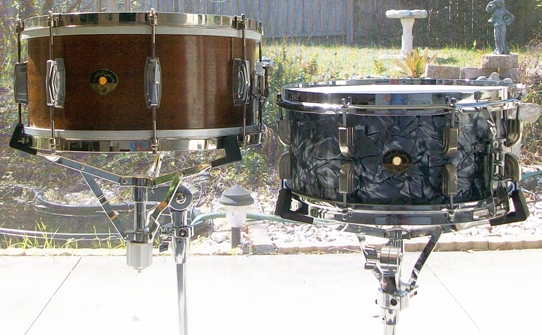Note that I typically use a single ride cymbal and hi-hats, so cymbal stands are the least of my worries: I have most of by bass drums equipped with shell-mounted cymbal hoolders, rendering cymbal stand selection moot (for me).
The high-hat stands are a wash, in my opinion, since I like the feel of each. Of course, the DW 6500 stand has more features in the way of memory locks, a nicer clutch and the DW name - at a higher price - than the Gibraltar 8607 stand.
Where I am less ambivalent is when the comparison is between the snare drum stands from each company: the Drum Workshop 6300 and the Gibraltar 8606. They both weigh about the same: approximately 2.5 kilograms, and folded the DW is 18" long and the Gibraltar is 16". Hands down I prefer the Gibraltar and here are the reasons:
- Will adjust lower
- Folds more compactly
- Smaller footprint and has the raised feet that I mentioned above on the cymbal stands

The top rim of the snare drum in the DW stand on the left, at its lowest possible position, is 26.5 inches high, whereas the top rim of the snare drum on the right sitting in the Gibraltar stand is 23.5 inches high. While three inches may not seem to be much, the photo tells the story.
A few close-up shots of the construction of the snare drum stands show that Drum Workshop's engineering is impeccable, albeit over engineered in my opinion.

Regardless of which you choose - DW or Gibraltar flat stands - and even if you use three of four cymbals in addition to hi-hats, either family of flat base stands will nicely fit into a 36" Beato hardware bag. I have managed to cram everything, including a bass drum pedal and throne into one of these compact bags, and recommend them for the lighter weight, flat base stands discussed above.
If you use one-up/one down kits, and are considering having a custom kit built, you may want to consider using the tried and true rail mount for your rack tom. In the past you had limited choices: the Drum Workshop or Gibraltar rail (both are atrocious in my opinion for a number of reasons, not the least of which neither hold the tom in position without slipping), the RCI rail, which is no longer being made, or salvaging a vintage rail and using it. There are too many compromises among those choices - and I should know because I suffered through each of them. My rail mount of choice these days is the Steve Maxwell Reproduction Rail Consolette. One thing I love about this rail is it can be retrofitted to vintage drums that used the two-hole Walburg & Auge rail that was used on Gretsch, Slingerland and other models (but not Ludwig, which used a 4-hole pattern), and it can also replace the modern DW and Gibraltar rails with no additional drilling. Most people balk at the $140.00 price, but few know that you are paying for items you may not need, such as the diamond plate and two types of spades that fit those plates. If you want only the rail assembly and 9.5 mm L-arm, Steve sells them for $85.00 (see the link above and go exploring.)
Another option, and one I took advantage of when I had my bubinga kit by Raven built is the Dunnett rail kit. I think the design is ingenuous, and like the fact that it can also be used to transform a floor tom into a bass drum.
I have aggregated all of the stands I discussed in this page for reference. If you have specific questions, please contact me and I will do my best to answer them.

No comments:
Post a Comment